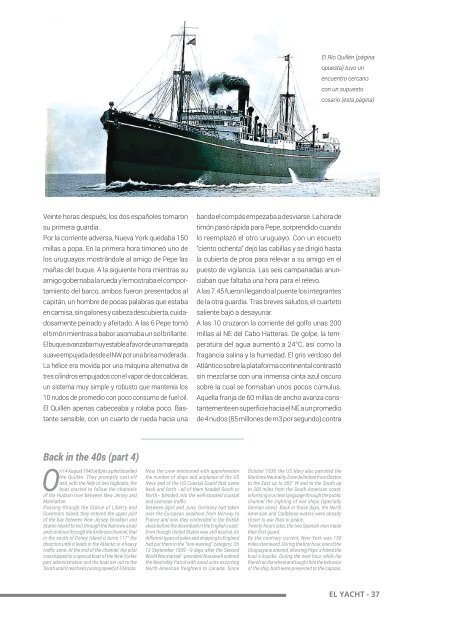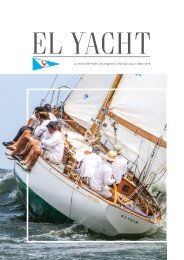El Yacht #214 - Agosto 2018
EL YACHT La Revista del Yacht Club Argentino Agosto 2018 - Numero 214
EL YACHT
La Revista del Yacht Club Argentino
Agosto 2018 - Numero 214
Create successful ePaper yourself
Turn your PDF publications into a flip-book with our unique Google optimized e-Paper software.
<strong>El</strong> Río Quillén (página<br />
opuesta) tuvo un<br />
encuentro cercano<br />
con un supuesto<br />
cosario (esta página)<br />
Veinte horas después, los dos españoles tomaron<br />
su primera guardia.<br />
Por la corriente adversa, Nueva York quedaba 150<br />
millas a popa. En la primera hora timoneó uno de<br />
los uruguayos mostrándole al amigo de Pepe las<br />
mañas del buque. A la siguiente hora mientras su<br />
amigo gobernaba la rueda y le mostraba el comportamiento<br />
del barco, ambos fueron presentados al<br />
capitán, un hombre de pocas palabras que estaba<br />
en camisa, sin galones y cabeza descubierta, cuidadosamente<br />
peinado y afeitado. A las 6 Pepe tomó<br />
el timón mientras a babor asomaba un sol brillante.<br />
<strong>El</strong> buque avanzaba muy estable a favor de una marejada<br />
suave empujada desde el NW por una brisa moderada.<br />
La hélice era movida por una máquina alternativa de<br />
tres cilindros empujados con el vapor de dos calderas,<br />
un sistema muy simple y robusto que mantenía los<br />
10 nudos de promedio con poco consumo de fuel oil.<br />
<strong>El</strong> Quillén apenas cabeceaba y rolaba poco. Bastante<br />
sensible, con un cuarto de rueda hacia una<br />
banda el compás empezaba a desviarse. La hora de<br />
timón pasó rápida para Pepe, sorprendido cuando<br />
lo reemplazó el otro uruguayo. Con un escueto<br />
“ciento ochenta” dejó las cabillas y se dirigió hasta<br />
la cubierta de proa para relevar a su amigo en el<br />
puesto de vigilancia. Las seis campanadas anunciaban<br />
que faltaba una hora para el relevo.<br />
A las 7.45 fueron llegando al puente los integrantes<br />
de la otra guardia. Tras breves saludos, el cuarteto<br />
saliente bajó a desayunar.<br />
A las 10 cruzaron la corriente del golfo unas 200<br />
millas al NE del Cabo Hatteras. De golpe, la temperatura<br />
del agua aumentó a 24°C, así como la<br />
fragancia salina y la humedad. <strong>El</strong> gris verdoso del<br />
Atlántico sobre la plataforma continental contrastó<br />
sin mezclarse con una inmensa cinta azul oscuro<br />
sobre la cual se formaban unos pocos cúmulus.<br />
Aquella franja de 60 millas de ancho avanza constantemente<br />
en superficie hacia el NE a un promedio<br />
de 4 nudos (85 millones de m3 por segundo) contra<br />
Back in the 40s (part 4)<br />
On 14 August 1940 at 8pm, a pilot boarded<br />
the Quillén. They promptly cast-off<br />
and, with the help of two tugboats, the<br />
boat started to follow the channels<br />
of the Hudson river between New Jersey and<br />
Manhattan.<br />
Passing through the Statue of Liberty and<br />
Governors Island, they entered the upper part<br />
of the bay between New Jersey, Brooklyn and<br />
Staten Island to exit through the Narrows strait<br />
and continue through the Ambrose channel, that<br />
in the south of Coney Island it turns 117° the<br />
direction until it leads in the Atlantic in a heavy<br />
traffic zone. At the end of the channel, the pilot<br />
transhipped to a special boat of the New Yorker<br />
port administration and the boat set out to the<br />
South until it reached cruising speed of 10 knots.<br />
Now, the crew mentioned with apprehension<br />
the number of ships and airplanes of the US<br />
Navy and of the US Coastal Guard that came<br />
back and forth –all of them headed South or<br />
North– blended into the well-stocked coastal<br />
and overseas traffic.<br />
Between April and June, Germany had taken<br />
over the European seashore from Norway to<br />
France and now they contended in the British<br />
skies before the disembark in the English coast.<br />
Even though United States was still neutral, its<br />
different types of sales and shipping to England<br />
had put them in the “non-warring” category. On<br />
12 September 1939 –9 days after the Second<br />
World War started– president Roosevelt ordered<br />
the Neutrality Patrol with naval units escorting<br />
North American freighters to Canada. Since<br />
October 1939, the US Navy also patrolled the<br />
Maritime Neutrality Zone delimited from Boston<br />
to the East up to 065° W and to the South up<br />
to 300 miles from the South American coast,<br />
informing in a clear language through the public<br />
channel the sighting of war ships (specially<br />
German ones). Back in those days, the North<br />
American and Caribbean waters were already<br />
closer to war than to peace.<br />
Twenty hours later, the two Spanish men made<br />
their first guard.<br />
By the contrary current, New York was 150<br />
miles sternward. During the first hour, one of the<br />
Uruguayans steered, showing Pepe´s friend the<br />
boat´s knacks. During the next hour, while his<br />
friend ran the wheel and taught him the behavior<br />
of the ship, both were presented to the captain,<br />
EL YACHT - 37




